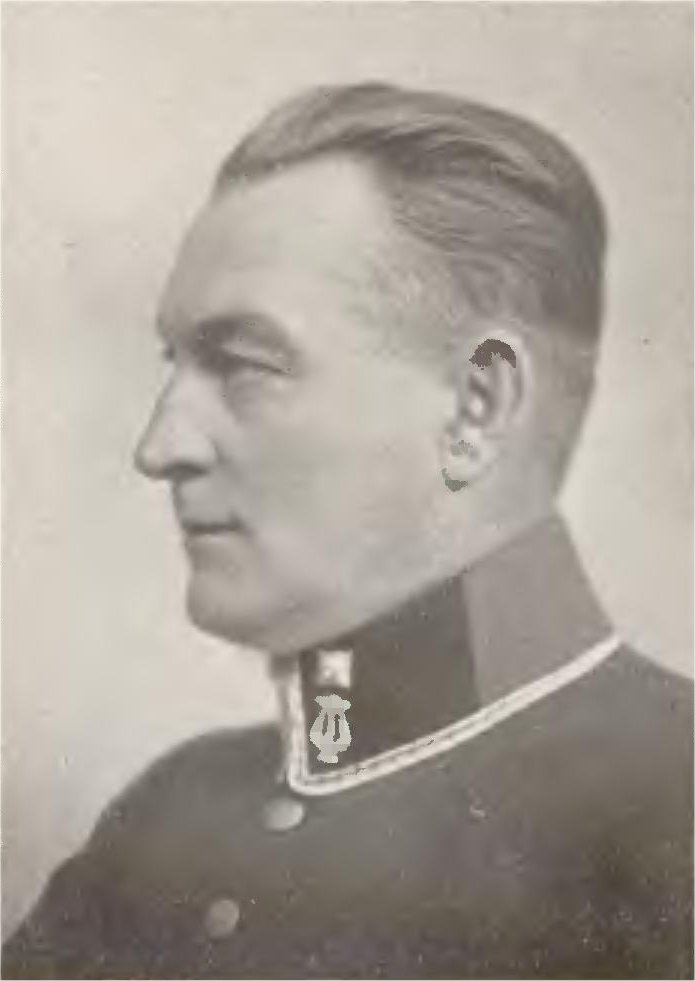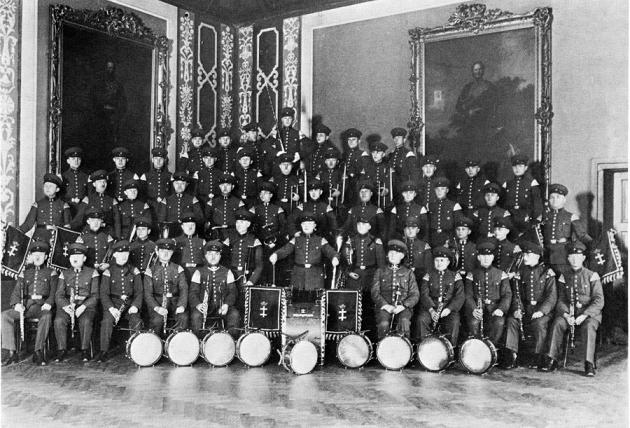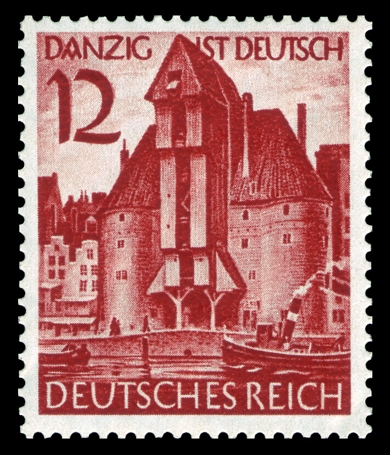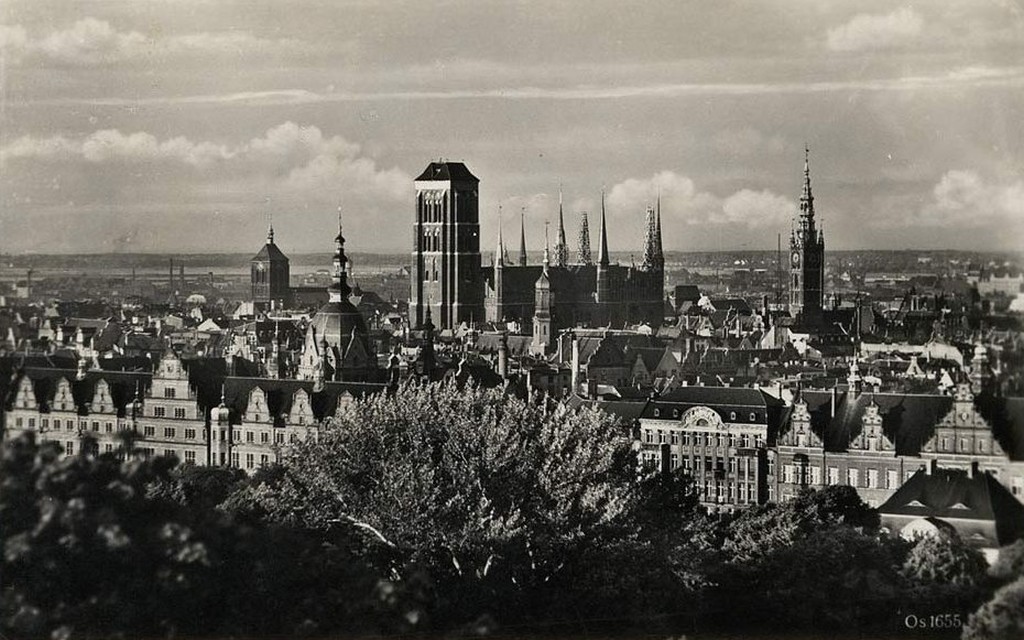 Loading... Please wait...
Loading... Please wait...Danzig's Musikmeister: Ernst Stieberitz
Posted by Brandenburg Historica on 3rd Apr 2016
Ernst Stieberitz, conductor of the Kapelle der Schutzpolizei Danzig throughout the entire quarter-century of its existence, was born at Cöthen in Anhalt on 31 May 1877.

He received his initial musical education at the Musikschule at
Camburg an der Saale and began his military career in 1896 as a fifer in the
band of the 8. Rheinisches Infanterie-Regiment Nr. 70 at Saarbrücken. In 1902, Stieberitz
enrolled in Berlin's Royal Academy of Music as a Musikmeister candidate; he completed this training on 29 July 1905, and on 1 May
1906, he was promoted to Stabshoboist and appointed Music Director of
the Band of the Danziger Infanterie-Regiment 128 at Danzig, West
Prussia. He held this position throughout the First World War, returning to his garrison with the rank of major for the demobilization of his regiment on 16 December 1918.
After briefly serving as music director of Infanterie-Regiment 101 of the Reichswehr (from which he was discharged in 1919), Stieberitz remained in Danzig and took over the job of conductor of the police band of the newly proclaimed “Free City of Danzig”- an entity which the Versailles powers had established as an extemporized solution to the problem of Poland's access to the sea. Stieberitz would remain in this post throughout the next two tumultuous decades of German-Polish relations, which included the economically-driven tensions of the late twenties, the temporary German-Polish detente of 1934, the emergence of the NSDAP as the leading factor in Danzig politics and the increasing German-Polish friction of the late thirties - which culminated in the return of Danzig to the Reich, only to be followed by the war years and, finally, the catastrophic end of the German East in 1945.
Throughout the twenties, Stieberitz - who was promoted to Obermusikmeister in 1920 - and his band (which was officially established on 9 April 1920 as the Kapelle der Schutzpolizei Danzig) provided military music to the government of the Free City for its ceremonial- and state occasions. That they performed this function superbly is perhaps unsurprising, given that their complement included numerous veteran musicians drawn from the band of the former Infanterie-Regiment 128. What is certain is that the ensemble quickly earned recognition as one of the foremost German military orchestras then in existence, though the "state" it served was no longer "in" Germany and was caught in an unprecedented and tragic situation. Danzig was a once-thriving port that had been politically severed from its economic hinterland; a "country" that was defended only by police forces; a polity governed by an elected Senate subject to the dictates of a League of Nations High Commissioner; and it was a "state" with foreign military personnel garrisoned at the entrance of its commercial harbor, in compliance with a treaty signed under duress.

As might be expected, this situation did much to inflame nationalist sentiment within the Free City and its environs. Stieberitz followed a path that had already been trod by many before him when he joined the NSDAP on 1 May 1933 (his party membership number was 2.232.447). Incredibly, he was soon denounced for having alleged “non-Aryan” antecedents by Hans Brückner and Christa-Maria Rock, the joint authors of "Jewry and Music: With an ABC of Jewish and Non-Aryan Musical Zealots," an encyclopedia of "racially suspect" musicians that was published in Munich in 1935. As a result, Stieberitz was temporarily put on hiatus, though he was eventually fully exonerated of these "charges" and reinstated. As an aside, it should be noted that the editors of this hysterical compilation, which was rife with false and libelous denunciations, were cited as defendants in no fewer than eighty-six civil actions and complaints (some of which were forwarded to the President of the Reich Chamber of Music) that were initiated by persons whose reputations they had compromised.
Following this ludicrous interregnum, Stieberitz resumed his work; on 20 June 1936, he and his band participated in a concert presented at the posh seaside resort of Zoppot (which lay within the boundaries of the Free City) that featured operatic stars from the Teatro alla Scala of Milan. The following year, they returned to Zoppot to perform on the “Tag der Deutschen Militärmusik,” an occasion which saw Stieberitz and his musicians playing alongside visiting Musikkorps from the Reich. Busy and much in demand, the Danzigers' lenghty 1937 tour of Germany had concluded a mere ten days before this event, and it included appearances in Berlin, Breslau (where they performed at the Deutsches Sängerbundfest in the presence of Hitler), Guben, Görlitz, Leipzig, Halle, Dresden and Schneidemühl.
On 20 April 1938, Stieberitz conducted the newly-renamed Musikkorps der Schutzpolizei der Freien Stadt Danzig in the first gala concert to be held in the Free City in honor Adolf Hitler’s birthday - an event which indicates the extent to which the NSDAP had achieved preeminence in Danzig by that time. On the day of that first Führer-Geburtstagskonzert, Stieberitz was promoted Hauptmann der Schutzpolizei.

By the summer of 1939, Polish-German relations had broken down and war seemed increasingly likely. On 1 September 1939, the battleship Schleswig-Holstein began shelling the Polish garrison at Westerplatte, the ammunition depot at the mouth of Danzig's sea harbor; simultaneously, personnel of the Danzig Schutzpolizei (along with the SS-Heimwehr 'Danzig') launched an attack on the city's Polish Post Office, while the Schutzpolizei's port security detachment moved up to join the forces besieging Westerplatte.
Stieberitz and his band soon found themselves providing musical accompaniment to the mass-celebrations surrounding Adolf Hitler's triumphal entry into Danzig on 19 September 1939, an event followed by his speech in the city's Renaissance Artus-Hof in which the Führer proclaimed the end of the Polish state and proffered peace to the Anglo-French alliance.
After the end of the Polish Campaign, Danzig (and the eastern regions of the Reich as a whole) settled into a routine that had many of the attributes of peacetime. In his regular work, Stieberitz had long collaborated with the Sender Danzig, which broadcast his performances and compositions with considerable frequency before the war. This association continued after the autumn of 1939 with little interruption, and a considerable body of recorded material (much of it subsequently lost) resulted from these joint efforts. Even after his promotion to Major der
Schutzpolizei in 1942, Stieberitz maintained a hands-on approach to his cooperation with the station's management; it is known that the last of his many broadcast performances featured the combined bands of the Schutzpolizei Danzig and the Wehrmacht-Kompagnie Danzig in a rendition of the Schwedischer Kriegsmarsch, which was recorded in a special studio session on 17 July 1944.
Stieberitz had achieved widespread international recognition early in his career; his march Unter dem Gardestern became popular well before the First World War, even as far away as America, where it was recorded in 1914 by the United States Marine Band ("The President's Own") under its Hanoverian-born music director, William Santelmann. The greater part of his work, however, reflected the spiritual commitment he made when he consciously linked his personal- and musical destiny to that of the German East.
Much of Stieberitz's artistic output was dedicated to recalling the history and living heritage of the "Land of the Teutonic Knights." His compositions in this vein included his cavalry-fanfare march (in an apparent "Galopp" work-tempo) Am Tannenberg-Denkmal; the Danziger Landesschützenmarsch; Feste Pillau; Die Burg im Osten; Danziger-Standartenlied and Pillauer Matrosen. Stieberitz's Präsentiermarsch der Freien Stadt Danzig (also known as Dies Land bleibt deutsch), first broadcast over the Reichssender Königsberg in 1934, is not to be confused with another one of his compositions - a cavalry fanfare march - that is known by the same alternate title, but which bears no musical resemblance to it whatsoever.
Among his other notable marches were his driving Sommekämpfer; An der Rawka 1914-1915 (recalling a particularly grueling First World War engagement between German- and Imperial Russian armies in the Lodz region); the naval march Großdeutschlands
blaue Jungen (1939) and Das grüne
Korps (1942), a piece written in honor of the green-uniformed Danzig
police among whom he had spent much of his career. Stieberitz wrote a total of sixty marches in all, as well as an operetta titled Der Weltmeister ("The World Champion") and incidental music for a presentation honoring the exploits of the Danzig 128th Infantry Regiment in the Great War.
As the armies of Soviet Marshal Rokossovsky closed in on Danzig in March 1945, all available forces, including the Volkssturm and the Schutzpolizei (with the personnel of the latter's Musikkorps among them), were mobilized by Gauleiter Albert Forster and thrown pell-mell into the desperate, last ditch defense of the ancient Frei- und Hansestadt.
At Danzig-Bohnsack on 27 March 1945, Ernst Stieberitz succumbed to severe wounds suffered in a ground attack by Soviet aircraft. The city where he spent most of his life, and to which he had devoted so much of his creative energy, fell to the Red Army on the following day. German Danzig vanished from the map, and from its ruins there emerged the Polish Gdańsk, which lay far to the east of postwar Germany's drastically redrawn and truncated borders.
The lands of the Teutonic Knights have disappeared and passed into history, perhaps for centuries, perhaps forever. Ernst Stieberitz, whose name and music will be linked with them for a long time to come, was not merely a man of a bygone era; he was a man of a bygone world.

Copyright © 2016 Brandenburg Historica, LLC
